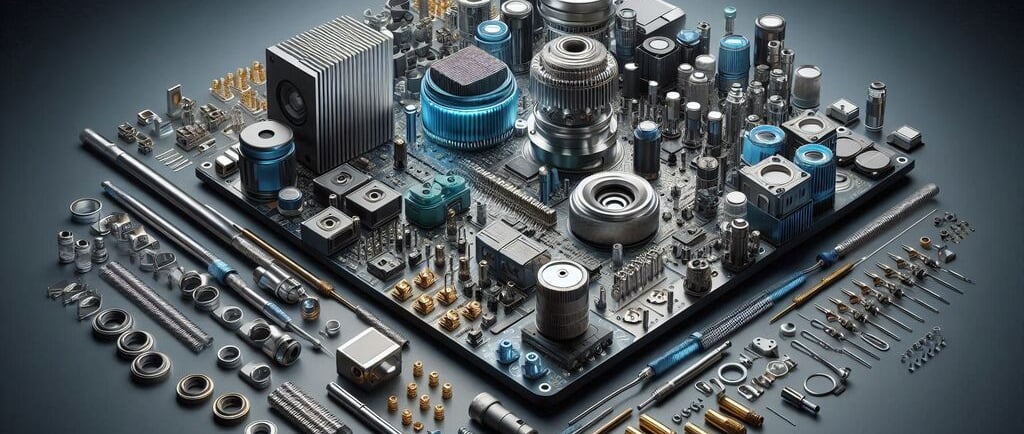Let us collaborate to foster global growth and development together.
Electronic Components & Industrial Parts
At Addinov, we provide an extensive range of electronic components and industrial parts designed to meet the diverse needs of various sectors.
11/15/20073 min read


Discover the essentials of electronic components and industrial parts. Learn how to choose, maintain, and optimize them for better performance and efficiency.
The Ultimate Guide to Electronic Components & Industrial Parts
In today’s tech-driven world, electronic components and industrial parts are the backbone of countless industries. From manufacturing to robotics, these tiny yet powerful elements keep the wheels of innovation turning. But with so many options available, how do you choose the right components for your needs? In this guide, we’ll break down everything you need to know about electronic components and industrial parts, from selection to maintenance. Let’s dive in!
Why Electronic Components and Industrial Parts Matter
The Heart of Modern Technology
Electronic components like resistors, capacitors, and microchips are the building blocks of modern devices. Without them, your smartphone, laptop, or even your car wouldn’t function. Similarly, industrial parts such as bearings, valves, and actuators keep machinery running smoothly in factories and plants.
Efficiency and Reliability
High-quality components ensure that your systems operate efficiently and reliably. For instance, using premium-grade capacitors can prevent overheating in electronic circuits, while durable industrial bearings reduce friction and wear in heavy machinery.
Cost-Effectiveness
Investing in the right components may seem expensive upfront, but it saves money in the long run. Reliable parts reduce downtime, minimize repair costs, and extend the lifespan of your equipment.
How to Choose the Right Electronic Components
Understand Your Requirements
Before purchasing any component, clearly define your project’s needs. Ask yourself:
What is the voltage, current, and power rating required?
What environmental conditions will the component face (e.g., temperature, humidity)?
Are there specific size or weight constraints?
Quality Over Price
While it’s tempting to go for the cheapest option, low-quality components can lead to frequent failures and safety hazards. Always opt for reputable brands and suppliers, even if it means spending a bit more.
Compatibility Matters
Ensure that the components you choose are compatible with your existing systems. For example, a microcontroller with the wrong pin configuration won’t integrate seamlessly into your circuit design.
Top Tips for Selecting Industrial Parts
Know Your Machinery
Different machines require different parts. For example:
Bearings: Choose between ball bearings, roller bearings, or plain bearings based on load and speed requirements.
Valves: Select from gate valves, ball valves, or butterfly valves depending on flow control needs.
Actuators: Decide between electric, hydraulic, or pneumatic actuators based on power and precision requirements.
Prioritize Durability
Industrial environments can be harsh, with exposure to dust, moisture, and extreme temperatures. Opt for parts made from robust materials like stainless steel or high-grade polymers to ensure longevity.
Consider Maintenance Needs
Some parts require regular lubrication or calibration. Choose components that align with your maintenance capabilities to avoid unexpected breakdowns.
Maintaining Your Electronic Components and Industrial Parts
Regular Inspections
Routine checks can help you spot issues before they escalate. For example:
Inspect circuit boards for burnt or corroded components.
Check industrial parts like belts and chains for signs of wear and tear.
Cleanliness is Key
Dust and debris can impair the performance of both electronic and industrial components. Use compressed air to clean circuit boards and wipe down machinery regularly.
Proper Storage
Store spare components in a cool, dry place to prevent damage. Use anti-static bags for electronic parts to avoid electrostatic discharge, which can fry sensitive circuits.
Real-Life Scenarios: The Impact of Quality Components
Case Study: The Manufacturing Plant
A factory producing automotive parts faced frequent downtime due to failing bearings. After switching to high-quality, heat-resistant bearings, their machinery ran 30% longer between maintenance cycles, boosting productivity.
Case Study: The Robotics Startup
A robotics startup struggled with overheating motors in their prototypes. By upgrading to motors with better thermal management and using high-performance capacitors, they achieved smoother operation and longer battery life.
Future Trends in Electronic Components and Industrial Parts
Miniaturization
As technology advances, components are becoming smaller and more powerful. This trend is particularly evident in consumer electronics, where devices like smartwatches pack incredible functionality into tiny packages.
Smart Components
The rise of the Internet of Things (IoT) has led to the development of smart components that can communicate and self-diagnose. Imagine a bearing that alerts you when it needs lubrication or a capacitor that adjusts its capacitance based on load conditions.
Sustainability
Eco-friendly materials and energy-efficient designs are gaining traction. For example, biodegradable circuit boards and solar-powered sensors are paving the way for a greener future.
Final Thoughts: Elevate Your Systems with the Right Components
Choosing and maintaining the right electronic components and industrial parts is crucial for achieving optimal performance and reliability. By understanding your needs, prioritizing quality, and staying ahead of industry trends, you can ensure that your systems run smoothly for years to come.
So, what’s your next step? Share your experiences with electronic components or industrial parts in the comments below, or explore our related articles on industrial automation and circuit design tips. Let’s build a smarter, more efficient future together!
Innovation
Cutting-edge solutions for industrial efficiency and productivity.
© 2024. All rights reserved.


